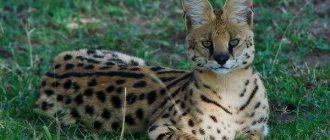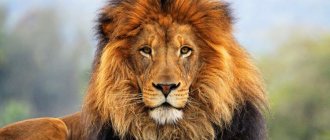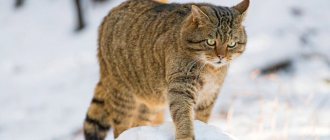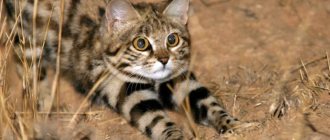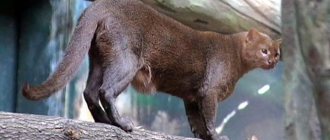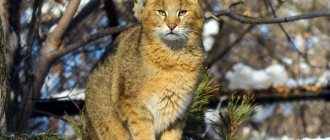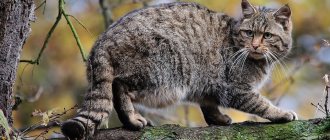Description
Pumas are the fourth largest feline in the world, and the second largest in the Americas, behind only the tiger, lion and jaguar. Body length is in the range of 100-180 cm, tail length is 60-75 cm, height is from 60 to 90 cm, weight is about 100 kg. Females are always slightly smaller than males.
Body type
— Advertising —
The body is flexible, elongated, relatively short legs, and the head is small. The hind legs are larger than the front legs. The pubescent tail is long and muscular. The paws are wide, the claws are sharp, curved, and retractable.
Color
The coat is thick, short and coarse. The color is uniform, in an adult puma it is grayish-brown or brownish-yellow, the belly is slightly lighter than the back. There are white markings on the chest, throat and belly, there are black spots on the muzzle, the ears are dark, and the tail has a black tip. In nature, there are light and even white cougars, and dark brown ones. Pumas in the tropics are smaller and redder, while residents of the northern regions of their range are gray in color. In general, the color of the puma is similar to the color of the main prey of the predator - deer. The fur of the cubs is thicker, covered with dark spots, stripes on the paws, and rings on the tail.
Puma is a quiet and graceful predator
In the cat family, the puma is considered one of the most graceful, strong, beautiful animals, first described in the mid-16th century. Another name for this big cat is cougar, or mountain lion.
What does it eat?
The puma is a nocturnal hunter. Its diet includes ungulates: black-tailed, white-tailed, pampas deer, elk, elk, caribou, bighorn and livestock. But cougars can hunt a variety of animals, including mice, squirrels, opossums, rabbits, muskrats, sloths, agoutis, monkeys, porcupines, Canadian beavers, raccoons, skunks and armadillos, coyotes, lynxes, and alligators. They eat birds, fish, snails and insects. They can also attack domestic animals.
Features of hunting
During a hunt, a cougar uses the factor of surprise: it sneaks up on large prey from behind and jumps on its back, breaking its neck with its weight, or grabbing it by the throat and begins to strangle the animal. A puma needs 860-1300 kg of meat per year (48 ungulates). The puma hides the remaining meat, covers it with leaves and brushwood, so that later it can return to the hidden prey.
Nutrition
The mountain lion hunt begins at dusk and continues at night. The objects of prey are artiodactyls, which exceed the puma in size and weight. In an open confrontation, the fight could end in the defeat of the hunter. But cunning and ingenuity, the factor of surprise, are the main advantages of the predatory puma. The animal chooses a place for an ambush on the leeward side so that its scent is elusive to the potential victim.
Puma stalking prey
Patiently waiting for the moment, an accurate and quick jump on the back of the victim does not leave even an elk or a large bull a chance to fight. The puma twists its neck with its fangs and gnaws the throat of its prey. The puma's diet most often includes ungulate mammals and rodents, but the hungry predator does not refuse other animals. The menu includes:
- deer, including caribou, wapiti, whitetails, etc.;
- moose;
- bighorn sheep;
- porcupines;
- lynx;
- sloths;
- opossums;
- monkey;
- coyotes;
- proteins;
- beavers;
- rabbits;
- armadillos, etc.
On rare occasions, pumas have been observed engaging in cannibalism. Hunting for large alligators, baribals, and grizzly bears is interspersed with catching birds, catching fish, insects, even snails. The omnivorous factor helps the animal survive in difficult conditions of lack of food. Sometimes the cougar pays with its life for attacks on cattle farms and farmsteads, where it does not spare cats, dogs, or poultry.
Cougars male (left) and female
In a year, a cougar eats approximately 1,300 kg of meat. A feature of the predator is the desire to obtain food with a reserve for future needs. The puma carries the remains of uneaten carcasses and hides them in secluded places, covering the meat with leaves and branches. The Indians, having studied the habits of the puma, followed it to pick up the untouched carcasses of the animals. Caches with supplies have more than once become the prey of other predators.
Where do they live?
— Advertising —
The cougar's historical range in the Americas was very wide, with the species occurring everywhere from southern Patagonia to southeastern Alaska. Now the predator is preserved in the USA and Canada, in the mountainous regions in the west, as well as in South America to Patagonia. In eastern North America, cougars have been completely extirpated, except for a small population of the subspecies Puma concolor coryi in Florida.
Species and man
In 1553, one of its first descriptions was given in the book “Chronicle of Peru” by Cies de Leon. The word "puma" comes from Quechua, the most widely spoken American Indian language.
People have long admired the grace and strength of this cat. In South America, a person's complex name often included the name of a powerful cat. The image of a puma is often found on ceramic products. The Incas associated this animal with the god of sky and thunder. In North America, for example among the Apaches, the screams made by the puma were a harbinger of death. Other Indian tribes identified this beast with an evil spirit from the underworld. At the same time, in the Cherokee tribe he was a sacred animal and was inviolable.
The cougar usually avoids humans, attacks are rare and occur in the summer or autumn, when young cougars leave their mothers and develop new territory. Between 1890 and 1990 In North America, 53 cougar attacks on humans were recorded, 40 of them resulted in injuries, and in 10 cases people died.
The cougar can attack livestock: calves, sheep, goats; this often happens when young animals learn to hunt. It is clear that this behavior displeased farmers, and their persecution significantly reduced the number of the beast in North America.
Puma subspecies
According to the main habitats for the puma, six subspecies are distinguished:
- Puma concolor couguar – inhabitant of North America (south from Canada to Guatemala and Belize);
- Puma concolor costaricensis - lives in Central America (in Nicaragua, Costa Rica and Panama);
- Puma concolor capricornensis - distributed in eastern South America (from the southern shores of the Amazon in Brazil to Paraguay);
— Advertising —
- Puma concolor concolor - found in the north of South America (Colombia, Venezuela, Guyana, Guiana, Ecuador, Peru, Bolivia);
- Puma concolor cabrerae - lives in the central regions of South America (in the northeast of Argentina, in Uruguay);
- Puma concolor puma is a resident of southern South America (Chile, southwestern Argentina).
Behavior
Pumas live both on the plains and in the mountains at an altitude of 4700 m above sea level, in a variety of landscapes: mountain coniferous forests, tropical forests, grassy plains, pampas, swampy lowlands.
The main criteria for choosing a place of life for a puma are the availability of shelters and prey. The muscular limbs of the puma help the predator make jumps of up to 6 m in length and up to 2.5 m in height, and reach speeds of up to 50 km/h over short distances. Pumas easily move along mountain slopes, can climb trees and rocks, and swim well. This animal is very quiet, and produces loud screams, reminiscent of a human scream, only during the breeding season.
Lifestyle
The puma is characterized by a solitary lifestyle. The female's hunting territory covers an area of 26-350 km², and is located on the outskirts of the male's territory. The male's range is from 140 to 760 km². Adult males avoid each other and do not enter other people's areas. Cougars roam their territory seasonally. Territory boundaries are marked by scratches on trees and excrement.
Features and habitat
A large mammal, second in size in its habitat only to its rival jaguar, reaches a length of approximately 120-170 cm, and with a tail - up to 2.5 m. The body height of an adult puma cat is from 60 to 75 cm, weight is 75-100 kg . Males are larger than females by an average of 30%.
The reddish fur on the neck and chest is of a light shade, on the head it is grayish, and on the ears and tail brush it is of thick dark tones, almost black. In general, the lower part of the body is much lighter than the upper part.
Predators living in North America are distinguished by silvery tints, while representatives of the southern pampas and tropics are closer to red tones. These are the only American cats with a uniform coat color. The animal's fur is short, rough and dense.
The puma animal has strong teeth, which are used to determine the age of the predator. The canines are used to capture prey, and the incisors easily tear tissue and break bones. A strong, muscular tail helps the American cat balance when moving and jumping while hunting.
The flexible, elongated body is distinguished by special grace. The head is small, the ears are small and round in shape. The paws are low and wide. The hind legs are stronger and more massive than the front legs. The number of toes on the paws is different: the hind ones have four, and the front ones have five.
The habitat of the puma predator is various landscapes: both flat areas with tropical forests, pampas, swampy lowlands, and mountainous coniferous areas in South and North America to the middle part of Canada. Silver lions avoid northern latitudes.
The animal's habitat is vast, but at the beginning of the last century, pumas were almost exterminated in the United States. The rare animal, the puma, has even begun to be domesticated. Years later, it was possible to restore a population comparable in size and distribution to leopards and lynxes. It has been noticed that the puma lives mainly where the main objects of its hunt – deer – live. Even their fur color is similar.
Reproduction
The puma does not have a specific mating season; in the north of its range it lasts from December to March. At this time, males often fight among themselves and scream loudly, trying to cover all the females who live on his territory. Estrus in females lasts approximately 9 days.
Pregnancy and kittens
Pregnancy lasts from 82 to 96 days. There are 1-6 babies in the litter, which weigh 226-453 g with a body length of approximately 30 cm. Their color is brown with black spots. The eyes open 8-10 days after birth. At the same time, the first teeth erupt. From 6 weeks, kittens begin to gradually switch to adult food. The mother continues to feed them milk and bring meat. The babies live with their mother until 15-26 months, after which they go to their own areas.
Puberty
Females become sexually mature at 2.5 years, males at the age of 3 years.
In nature, the life expectancy of a puma is 18-20 years.
Hunting and prey
During a hunt, the cougar first tracks the animal, and then jumps on its back and begins to strangle it with its powerful jaws, breaking the cervical vertebrae. After this, it drags the prey to a quiet place, where it eats only part of it. The remaining meat is hidden by pouring leaves, snow and branches on top. The puma checks its supplies regularly. Large prey usually lasts for 10 days.
Females feed their offspring independently and go hunting every 3 days. The puma does not eat dead animals or carrion, but can hunt livestock: sheep or goats. In a year, one cougar can eat up to 1.3 tons of meat, which corresponds to approximately 48 individuals of ungulates.
Natural enemies of pumas
Pumas have no natural enemies, but they can still be dangerous from predators such as the jaguar, a pack of wolves, grizzly bears, black bears, crocodile, black caiman and the large Mississippi alligator.
Grizzlies and baribals often take prey from pumas. Although cougars are hunted and their natural range is declining due to environmental destruction, subspecies are still numerous, as cougars can live in a wide variety of conditions. For example, the population in the United States was almost completely exterminated by the beginning of the 20th century, but now it already numbers 30,000 individuals and continues to spread throughout nearby territories.
Three subspecies of pumas are listed in Appendix I of CITES: Puma concolor coryi, Puma concolor costaricensis, Puma concolor couguar. The only subspecies, the Florida cougar (Puma concolor coryi), is listed as critically endangered on the IUCN Red List. Puma hunting is now restricted and banned, but the animals are still often killed by local farmers due to the harm they can cause to livestock.
Interesting Facts:
- Cougars rarely attack people and prefer to avoid them. If a person moves quickly and is alone, then at dusk or at night a cougar may mistake him for prey and attack.
- The age of a puma is determined by the condition of its teeth. The animal's milk teeth erupt at 4 months. Permanent teeth appear at 6-8 months, and by 1.5-2 years they are completely erupted. With age, they noticeably wear off and darken.
- The puma is capable of dragging its prey over a long distance, even if it weighs 5-7 times more than the predator itself. The Indian tribes who lived in California used this habit of pumas, and picked up eaten and untouched carcasses after predators.
Keeping animals at the Moscow Zoo
During the existence of the zoo, pumas were kept here several times. These cats live well in captivity and bear offspring. Currently, a young large male puma lives in “Cat Row”, who arrived from the Veliky Ustyug Zoo. He walks around the enclosure not only in the evening, like most cats, but is often active during the day. His daily diet includes 1.5 kg of beef, a little ox heart and 4-5 rats, which he eats with great appetite. The beast greets familiar people with a uterine sound that vaguely resembles a purr. We hope that our handsome guy will soon have a girlfriend, and they will make us happy with the birth of little spotted kittens.
